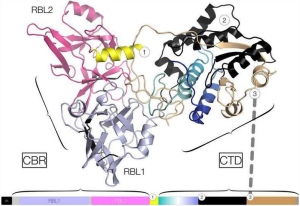A group from Section of Infectious Diseases, Department of Internal Medicine, Yale University School of Medicine, New Haven, CT, USA, etc. has reported that virulence-modifying (VM) proteins are novel R-type lectins containing tandem N-terminal ricin B-chain-like β-trefoil domains
https://www.ncbi.nlm.nih.gov/pmc/articles/PMC9002632/
The so-called virulence-modifying (VM) proteins contributes to the pathogenesis of leptospirosis. Leptospirosis is a globally important neglected zoonotic disease.
From the homology searches of virulence-modifying (VM) proteins (PF07598), tandem ricin B-like lectin subdomains were identified in the amino–terminal regions of that protein. If so, ricin B chain, leptospiral VM proteins could bind to terminal galactose and N-acetyl-galactosamine residues, such as asialofetuin, as a model protein.
Actually, it was confirmed experimentally that the recombinant VM protein expressed in E. coli bound to asialofetuin, showing similar carbohydrate-binding specificity to ricin B chain as determined by competitive asialofetuin-binding assays.
Leptospira VM proteins bound to, and are quickly internalized by, HeLa cells via an N-terminal R-type lectin domain with specificity for terminal galactosyl residues. Cell surface binding and internalization were shown to be rapid, occurring within 30 min after exposure, and induced pleiotropic effects on HeLa cells, including actin depolymerization, caspase-3 activation, nuclear fragmentation, and ultimately blebbing and cell death.
One mechanism of cell death appears to be originated with genomic DNA degradation, which occurs after nuclear localization of the VM protein. Corroborating in vitro experiments using purified HeLa cell genomic DNA, and supercoiled and linearized bacterial plasmid DNA indicates that VM proteins tested so far, possess DNase activities. It was found that CTD of VM protein possess conserved active site residues identical to bovine DNase I.
So, the combination of cell surface binding, internalization, nuclear translocation, and DNase functions indicate that VM proteins evolved as novel forms of the bacterial AB domain-containing toxin paradigm.

